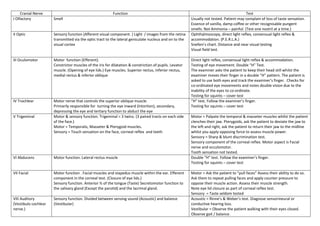
Overview of Cranial Nerve Examinations
- 1. Cranial Nerve Function Test I Olfactory Smell Usually not tested. Patient may complain of loss of taste sensation. Essence of vanilla, damp coffee or other recognisable pungent smells. Not Ammonia – painful. (Test one nostril at a time.) II Optic Sensory function (Afferent visual component. ) Light / images from the retina transmitted via the optic tract to the lateral geniculate nucleus and on to the visual cortex Ophthalmoscopy, direct light reflex, consensual light reflex & accommodation. (P.E.R.L.A.) Snellen’s chart. Distance and near visual testing Visual field test. III Oculomotor Motor function (Efferent). Constrictor muscles of the iris for dilatation & constriction of pupils. Levator muscle. (Opening of eye lids.) Eye muscles. Superior rectus, inferior rectus, medial rectus & inferior oblique Direct light reflex, consensual light reflex & accommodation. Testing of eye movement. Double “H” Test. The examiner asks the patient to keep their head still whilst the examiner moves their finger in a double “H” pattern. The patient is asked to use both eyes and track the examiner’s finger. Checks for co-ordinated eye movements and notes double vision due to the inability of the eyes to co-ordinate. Testing for squints – cover test IV Trochlear Motor nerve that controls the superior oblique muscle. Primarily responsible for turning the eye inward (Intortion), secondary, depressing the eye and tertiary function to abduct the eye “H” test. Follow the examiner’s finger. Testing for squints – cover test V Trigeminal Motor & sensory function. Trigeminal = 3 twins. (3 paired tracts on each side of the face.) Motor = Temporalis, Masseter & Pterygoid muscles. Sensory = Touch sensation on the face, corneal reflex and teeth Motor = Palpate the temporal & masseter muscles whilst the patient clenches their jaw. Pterygoids, ask the patient to deviate the jaw to the left and right, ask the patient to return their jaw to the midline whilst you apply opposing force to assess muscle power. Sensory = Sharp & blunt discrimination test. Sensory component of the corneal reflex. Motor aspect is Facial nerve and occulomotor. Tooth sensation not tested. VI Abducens Motor function. Lateral rectus muscle Double “H” test. Follow the examiner’s finger. Testing for squints – cover test VII Facial Motor function . Facial muscles and stapedus muscle within the ear. Efferent component in the corneal test. (Closure of eye lids.) Sensory function. Anterior ⅔ of the tongue (Taste) Secretomotor function to the salivary gland (Except the parotid) and the lacrimal gland. Motor = Ask the patient to “pull faces” Assess their ability to do so. Ask them to repeat pulling faces and apply counter pressure to oppose their muscle action. Assess their muscle strength. Note eye lid closure as part of corneal reflex test. Sensory = Taste seldom tested VIII Auditory (Vestibulo cochlear nerve.) Sensory function. Divided between sensing sound (Acoustic) and balance (Vestibular) Acoustic = Rinne’s & Weber’s test. Diagnose sensorineural or conductive hearing loss. Vestibular = Observe the patient walking with their eyes closed. Observe gait / balance.
- 2. Halpike’s test & Romberg’s test may be performed. (They are separate tests, testing different things.) IX Glossopharyngeal Glossopharyngeal continued…….. Sensory function. Posterior ⅓ of the tongue, tonsils and the pharynx. Secretions from the Parotid salivary gland. Motor function. Stylopharyngeus muscle – Elevation of the larynx and pharynx Dilates the pharynx to permit swallowing Sensory = Afferent component of eliciting a gag reflex. Taste test for the posterior ⅓ of the tongue very rarely performed. X Vagus Motor function. Laryngeal and pharyngeal muscles. Control of voice & resonance. Sensory function. Parasympathetic action to nearly all fibres from the head to the splenic flexure. Auditory canal & tympanum (Ear drum.) Ask the patient to say Ahhhhhhhhhhhhhhhhhh! Observe for flattening of the tongue, elevation of the palate and the symmetrical elevation of the uvula. If the uvula deviates then the lesion is on the opposing side to which it deviates. The patient will also exhibit a hoarse voice and difficulty swallowing. XI Accessory Motor function. Neck muscles. Sternocleidomastoid & trapezius Sternocleidomastoid. Ask the patient to turn their head to one side with the examiner applying gentle pressure to oppose this manoeuvre. If there is weakness or an inability to perform this then the lesion is in the contra lateral (Opposite) portion of this nerve. To test the trapezius muscle. The examiner places his hands on the patient’s shoulders and asks the patient to lift their shoulder whilst the examiner bears down. Any weakness is ipsilateral in origin. (Same side.) Remember to test both sides. This is an example of upper motor neurone lesion. (UMN) Lower motor neurone problem (LMN) would be as follows. Ask the patient to turn their head to the right whilst applying gentle pressure to prevent them returning to the midline. If they are unable to comply and additionally display weakness of the left shoulder then this characterises LMN X11 Hypoglossal Motor function. Tongue and other glossal muscles. Important for swallowing and voice articulation. Observe for tongue fasciculation. May indicate a peripheral lesion. Ask the patient to move their tongue through a range of movements. Then oppose these movements by applying gentle pressure to prevent them from moving their tongue in the indicated direction. Ask the patient to “stick” their tongue out. If there is a weakness then it will deviate to the side of the weakness as the unaffected side pushes it over.